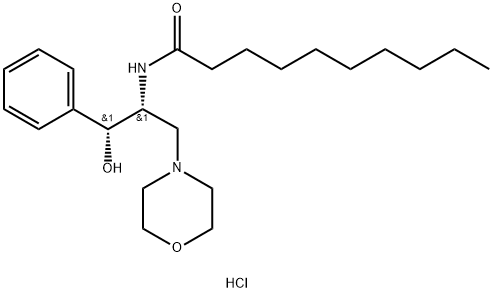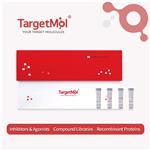Description
(+)-D-
threo-PDMP is a ceramide analog and is one of the four possible stereoisomers of PDMP .
1 (+)-D-
threo-PDMP is an inhibitor of glucosylceramide synthase.
2,3 It inhibits glucosylceramide synthase by 50% when used at a concentration of 5 μM in an enzyme assay.
3 (+)-D-
threo-PDMP is the active component of racemic DL-
threo-PDMP .
In vitro, (+)-D-
threo-PDMP inhibits the synthesis of glucosylceramide synthase and lactosylceramide in B16 melanoma cells when used at a concentration of 25 μM and inhibits cell binding to laminin and collagen when used at concentrations of 10 and 25 μM.
4 It also inhibits β-1,4-galactosyltransferase 6 (B4GALT6) and prevents lactosylceramide synthesis, which is a promotor of neuroinflammation in mice during chronic experimental autoimmune encephalomyelitis (EAE), a model of multiple sclerosis.
5 (+)-D-
threo-PDMP inhibits ganglioside biosynthesis, reduces long-term potentiation (LTP) in mouse hippocampal CA1 neurons, and impairs learning in the four-pellet taking test in mice.
6
References
1. Vunnam, R.R., and Radin, N.S.
Analogs of ceramide that inhibit glucocerebroside synthetase in mouse brain Chem. Phys. Lipids 26(3),265-278(1980).
2. Abe, A., Inokuchi, J.-i., Jimbo, M., et al.
Improved inhibitors of glucosylceramide synthase J. Biochem. 111(2),191-196(1992).
3. Inokuchi, J.i., and Radin, N.S.
Preparation of the active isomer of 1-phenyl-2-decanoylamino-3-morpholino-1-propanol, inhibitor of murine glucocerebroside synthetase J. Lipid Res. 28(5),565-571(1987).
4. Inokuchi, J.-I., Momosaki, K., Shimeno, H., et al.
Effects of D-threo-PDMP, an inhibitor of glucosylceramide synthetase, on expression of cell surface glycolipid antigen and binding to adhesive proteins by B16 melanoma cells. J. Cell. Physiol. 141(3),573-583(1989).
5. Mayo, L., Trauger, S.A., Blain, M., et al.
Regulation of astrocyte activation by glycolipids drives chronic CNS inflammation Nat. Med. 20(10),1147-1156(2014).
6. Fujiwara, H., Ikarashi, K., Yamazaki, Y., et al.
Impairment of hippocampal long-term potentiation and failure of learning in mice treated with D-threo-1-phenyl-2-decanoylamino-3-morpholino-1-propanol. Biomed Res. 33(5),265-271(2012).

